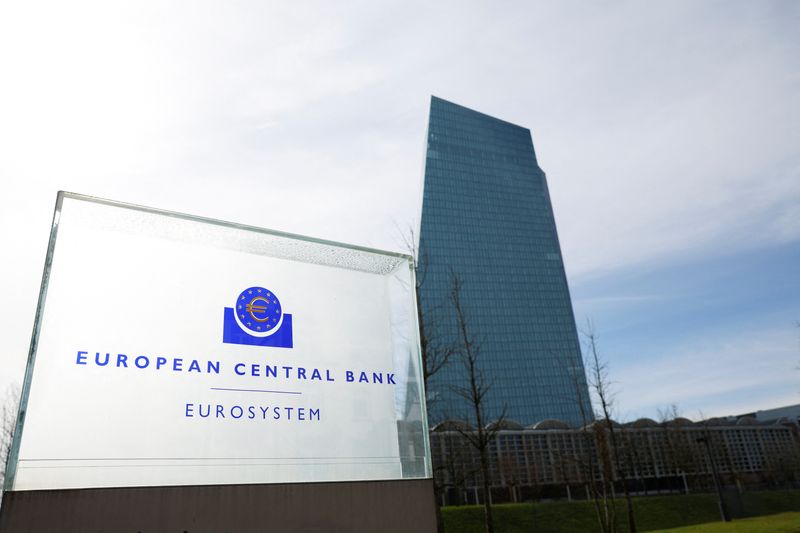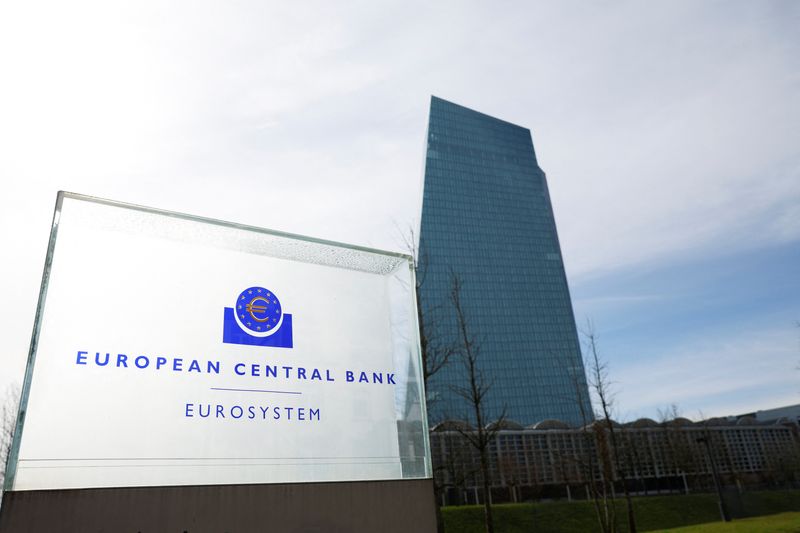Economy
Investors expect ECB rate-hike pause in September after dismal PMIs


© Reuters. FILE PHOTO: A view shows the logo of the European Central Bank (ECB) outside its headquarters in Frankfurt, Germany March 16, 2023. REUTERS/Heiko Becker/File Photo
By Yoruk Bahceli
(Reuters) -Traders on Wednesday firmed up bets that the European Central Bank would pause hiking interest rates in September, as sharp contractions in business activity pointed to deepening economic pain in Europe.
Traders now price in a roughly 40% chance of a 25 basis point move in September compared with a more than 50% chance they saw only on Tuesday.
That suggests they are leaning towards a pause in the ECB’s record-paced tightening cycle that has lifted rates from deep in negative territory to 3.75% in just a year.
German business activity contracted at the fastest pace in over three years in August and much more than analysts expected, data showed on Wednesday, deepening the downturn in business activity far more than thought across the euro zone. Britain’s business activity meanwhile contracted unexpectedly, raising recession risks.
Bond yields in the euro zone and Britain, recently propped up by a resilient U.S. economy, tumbled. The euro fell to more than a two-month low against the dollar and sterling dropped sharply as investors also scaled back their expectations for where ECB and Bank of England rates will peak.
“The PMI suggests that it’s back to the pre-summer narrative of lower rates,” said Danske Bank chief analyst Piet Christiansen.
Germany’s 10-year Bund yield, the benchmark for the euro area, dropped as much as 13.5 basis points to 2.519%, the lowest since Aug. 10.
Two-year German yields, sensitive to interest rate expectations, dropped similarly below 3%.
Euro zone consumer confidence fell by 0.9 points in August from the July number, while economists polled by Reuters had expected a rise to -14.3.
U.S. business activity approached the stagnation point in August, with growth at its weakest since February as demand for new business in the vast service sector contracted.
DIVERGING FORTUNES
In Britain, gilt yields were over 10 bps lower on the day across the yield curve and sterling dropped as much as 0.9% against the dollar.
Just last week, 10-year gilt yields had hit their highest levels since 2008 just above 4.7%.
Wednesday’s sharp falls in borrowing costs highlight how Europe’s weaker economy and outlook for borrowing costs diverges from resilience in the U.S. Strong U.S. data this month has prompted expectations that interest rates will remain higher for longer.
That sent U.S. Treasury yields to their highest in over a decade and lifted borrowing costs higher globally.
Highlighting the contrast in outlooks, U.S. Treasury yields dropped by much less than in Europe on Wednesday and traded with the highest yield relative to Germany’s since December at 173 bps, a headwind to the euro.
“The dovish case that high inflation is not the result of excess demand, but rather the result of exogenous shocks and therefore a contributor to weak growth, is strengthened by the PMI data,” Citi economists said in a note to clients.
“The risk that the ECB has already overtightened is significant. Today’s PMI release reduces the chances of a September rate hike (our base case) and increases the chance that rate cuts will come earlier than most Governing Council members thought,” they added.
JPMorgan (NYSE:) now expects the ECB to pause in September and has postponed its expectation of a final 25 bps hike to October, joining a narrow majority of economists polled by Reuters earlier in August who also expect a September pause.
While expectations were scaled back, traders still expect two more 25 bps rate hikes from the BoE, which is tackling higher inflation than the euro zone. They also still see just under a 60% chance of a 25 bps ECB rate hike by December.
Key to investor expectations from the ECB will be next week’s euro zone inflation data.
“There’s many indicators that suggest that we could have had the last hike but if you just look at inflation, which is the (ECB’s) key mandate… that is not a done deal,” Christiansen at Danske Bank said.
Economy
Russian central bank says it needs months to make sure CPI falling before rate cuts -RBC


© Reuters. Russian Central Bank Governor Elvira Nabiullina attends a news conference in Moscow, Russia June 14, 2019. REUTERS/Shamil Zhumatov/File Photo
MOSCOW (Reuters) – Russia’s central bank will need two to three months to make sure that inflation is steadily declining before taking any decision on interest rate cuts, the bank’s governor Elvira Nabiullina told RBC media on Sunday.
The central bank raised its key interest rate by 100 basis points to 16% earlier in December, hiking for the fifth consecutive meeting in response to stubborn inflation, and suggested that its tightening cycle was nearly over.
Nabiullina said it was not yet clear when exactly the regulator would start cutting rates, however.
“We really need to make sure that inflation is steadily decreasing, that these are not one-off factors that can affect the rate of price growth in a particular month,” she said.
Nabiullina said the bank was taking into account a wide range of indicators but primarily those that “characterize the stability of inflation”.
“This will take two or three months or more – it depends on how much the wide range of indicators that characterize sustainable inflation declines,” she said.
The bank will next convene to set its benchmark rate on Feb. 16.
The governor also said the bank should have started monetary policy tightening earlier than in July, when it embarked on the rate-hiking cycle.
Economy
China identifies second set of projects in $140 billion spending plan


© Reuters. FILE PHOTO: Workers walk past an under-construction area with completed office towers in the background, in Shenzhen’s Qianhai new district, Guangdong province, China August 25, 2023. REUTERS/David Kirton/File Photo
SHANGHAI (Reuters) – China’s top planning body said on Saturday it had identified a second batch of public investment projects, including flood control and disaster relief programmes, under a bond issuance and investment plan announced in October to boost the economy.
With the latest tranche, China has now earmarked more than 800 billion yuan of its 1 trillion yuan ($140 billion) in additional government bond issuance in the fourth quarter, as it focuses on fiscal steps to shore up the flagging economy.
The National Development and Reform Commission (NDRC) said in a statement on Saturday it had identified 9,600 projects with planned investment of more than 560 billion yuan.
China’s economy, the world’s second largest, is struggling to regain its footing post-COVID-19 as policymakers grapple with tepid consumer demand, weak exports, falling foreign investment and a deepening real estate crisis.
The 1 trillion yuan in additional bond issuance will widen China’s 2023 budget deficit ratio to around 3.8 percent from 3 percent, the state-run Xinhua news agency has said.
“Construction of the projects will improve China’s flood control system, emergency response mechanism and disaster relief capabilities, and better protect people’s lives and property, so it is very significant,” the NDRC said.
The agency said it will coordinate with other government bodies to make sure that funds are allocated speedily for investment and that high standards of quality are maintained in project construction.
($1 = 7.1315 renminbi)
Economy
Russian central bank says it needs months to make sure CPI falling before rate cuts -RBC


© Reuters. Russian Central Bank Governor Elvira Nabiullina attends a news conference in Moscow, Russia June 14, 2019. REUTERS/Shamil Zhumatov/File Photo
MOSCOW (Reuters) – Russia’s central bank will need two to three months to make sure that inflation is steadily declining before taking any decision on interest rate cuts, the bank’s governor Elvira Nabiullina told RBC media on Sunday.
The central bank raised its key interest rate by 100 basis points to 16% earlier in December, hiking for the fifth consecutive meeting in response to stubborn inflation, and suggested that its tightening cycle was nearly over.
Nabiullina said it was not yet clear when exactly the regulator would start cutting rates, however.
“We really need to make sure that inflation is steadily decreasing, that these are not one-off factors that can affect the rate of price growth in a particular month,” she said.
Nabiullina said the bank was taking into account a wide range of indicators but primarily those that “characterize the stability of inflation”.
“This will take two or three months or more – it depends on how much the wide range of indicators that characterize sustainable inflation declines,” she said.
The bank will next convene to set its benchmark rate on Feb. 16.
The governor also said the bank should have started monetary policy tightening earlier than in July, when it embarked on the rate-hiking cycle.

 Forex3 years ago
Forex3 years agoForex Today: the dollar is gaining strength amid gloomy sentiment at the start of the Fed’s week

 Forex3 years ago
Forex3 years agoUnbiased review of Pocket Option broker

 Forex3 years ago
Forex3 years agoDollar to pound sterling exchange rate today: Pound plummeted to its lowest since 1985

 Forex3 years ago
Forex3 years agoHow is the Australian dollar doing today?

 Cryptocurrency3 years ago
Cryptocurrency3 years agoWhat happened in the crypto market – current events today

 World3 years ago
World3 years agoWhy are modern video games an art form?

 Commodities3 years ago
Commodities3 years agoCopper continues to fall in price on expectations of lower demand in China

 Economy3 years ago
Economy3 years agoCrude oil tankers double in price due to EU anti-Russian sanctions





















